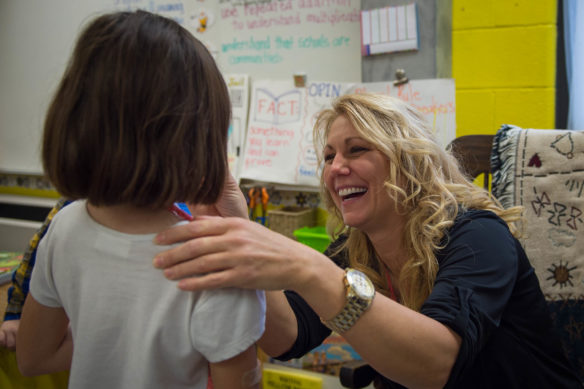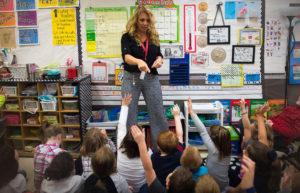
Kim Setty, a 2nd-grade teacher at Mary Goetz Elementary (Ludlow Independent) wipes the nose of a student during class. Setty and a group of northern Kentucky teachers are working to make the transition between districts easier for highly mobile students in the area.
Photo by Bobby Ellis, Dec. 2, 2016
By Brenna R. Kelly
Brenna.kelly@education.ky.gov
After five years teaching kindergarten at John G. Carlisle Elementary, Tiffany Gruen switched to teaching 5th grade at the Covington Independent school.
“My first group of kindergarteners should have been my first group of 5th-graders,” she said, “but there was only one student still left at the school.”
In fact, only three students from the entire grade level had made it to 5th grade at the 340-student school.
In neighboring Newport Independent, about 40 students leave the district each month, while another 40 or so new students take their place, said Superintendent Kelly Middleton.
“Transiency is such a big issue, but educators who haven’t experienced it really don’t know much about it,” he said. “Until you live it, you really don’t know what it’s like.”
There are seven Kentucky school districts in just 10 miles along northern Kentucky’s riverfront in Kenton and Campbell counties, including Kenton County, Ludlow Independent, Covington Independent, Newport Independent, Bellevue Independent, Dayton Independent and Campbell County. Five more independent districts – Southgate, Fort Thomas, Beechwood, Elsmere-Erlanger and Silver Grove – lie just to the south.
The geography – combined with high poverty rates and a heroin epidemic hitting the region – have led to a highly mobile student population in several of those districts, northern Kentucky educators say. With so many districts so close, a move of a few blocks could put a student in a new district. If a student enters foster care or moves in with a grandparent after a parent’s overdose, they too could end up in a new district.
“We have about four or five districts that are constantly interchanging students,” Gruen said.
And when those students walk into a new classroom, the teacher often has little information, either academic or social, about the student.
Ludlow Independent teacher Kim Setty recalled one student who was in the sixth school by the time she arrived in Setty’s 2nd-grade class.
“Had I had something on her, maybe just a sheet that said, here’s what she needs, I could have been more prepared to help her,” Setty said.

Kim Setty counts out the number of students who have green eyes during her class. Setty hopes the River City Project form will make it easier for students who frequently transfer to get the services they need quickly.
Photo by Bobby Ellis, Dec. 2, 2016
A group of teachers and administrators from several northern Kentucky districts, along with help from Kentucky Department Education, is now trying to change that. For the past year they’ve been working on the River City Project, an effort to get teachers the information they need.
“We know how much data schools collect on students and to not be able to access that easily is kind of frustrating for teachers who work with high-mobility students,” said Gruen, now a teacher at Erlanger-Elsmere. “We know that that data has been captured. If we can get our hands on it quickly, we can meet the needs of our students at a much quicker pace.”
Gruen worked with KDE instructional specialists Chris Crouch and Kelly Stidham to find other teachers who wanted to help. With Crouch and Stidham’s guidance, they attacked the work as action research – or research done with the goal of solving a problem.
Initially the teachers discussed devising a way to quickly assess the new students academically, Crouch said.
“We thought, we’re going to come in, we’re going to build these really high-level tasks built by teachers that will tell us where the students are at in literacy and in math,” he said. “The teachers came and they said, ‘We do not care about tasks, we need non-academic data.’”
So the focus quickly changed to address more immediate concerns. Does the student wear glasses? Do they need counseling services? Should they receive a backpack full of food on Friday?
“That’s the kind of basic information we need as teachers on the first day when that child walks into our classroom,” Gruen said.
The goal of the River City Project is to make sure students are getting the support they need without disruption just because of a move, said Setty, who is part of the group. Setty likened it to changing doctors and having a prescription disrupted because of a paperwork problem.
“I want it to be a seamless transition because we can’t stop the transitioning,” she said. “We need to make sure there’s a continuation of services and programs for these kids, that there’s not a hiccup.”
Not many 6- to 8-year-olds can tell a teacher exactly what services they were getting at their old school or even if they are supposed to be wearing glasses, she said.
While academic data is important, Setty said, that can come later. What’s important is that the students’ needs are met.
“Those MAP scores aren’t going to mean anything if you’re not getting the counseling and food that you need,” she said. “That what’s important to me. Do they feel loved and safe because somebody knows about their background a little bit?”
Research shows that relationships can improve student learning, said Middleton, who also is a part of the project. He has tried to bring that philosophy to his district by implementing home visits before each school year and creating a one-sheet student biography that is updated each year and given to next year’s teacher.
The district also has a welcome center to handle all new students’ registration.
“Kids work better and harder for people who care and know them,” he said. “It’s everything. A child in poverty who changes schools often right off the bat is going to know whether the new teacher knows and cares about him. And if they don’t, the student is not going try hard, they are not going to care.”
Middleton hopes that the project will allow Newport to get to know its new students in a more timely manner.
The group created a document teachers can use like a checklist for the services each new child receives. The goal is to eventually include academic indicators, “but first we need to meet the needs of our kids,” Gruen said.
“They want to give us the MAP scores or the Response to Invention information, that’s great,” she said, “but for us, the most important thing is that the child’s needs are being met without a month-long gap before the new teacher realizes what that child needs.”
The form is short so as not to place more work on the teacher and doesn’t include a narrative about the child because the group didn’t want to give the teachers preconceived notions. As of now, the form is something districts could put on their website for teachers to download, fill out and email to the new teacher.
“In our perfect world, it would just be a screen on Infinite Campus,” Gruen said. “But a lot of that is outside our control.”
The group is now trying to bring in more teachers and districts to create buy in from area teachers. The next step will be to ask principals to include the form as part of their school’s withdraw process.
Once a teacher receives one of the forms when a new student arrives, Gruen believes that the use of the form will grow quickly.
“When they see it as a benefit to receive that, then they will be willing to put in that same effort when one of their students leaves,” she said. “They will want to pay it forward.”
MORE INFO …
Tiffany Gruen Tiffany.Gruen@Erlanger.kyschools.us
Kelly Middleton Kelly.Middleton@Newport.kyschools.us
Kim Setty Kim.Setty@Ludlow.kyschools.us
Chris Crouch Chris.Crouch@education.ky.gov
Kelly Stidham Kelly.Stidham@education.ky.gov



Leave A Comment